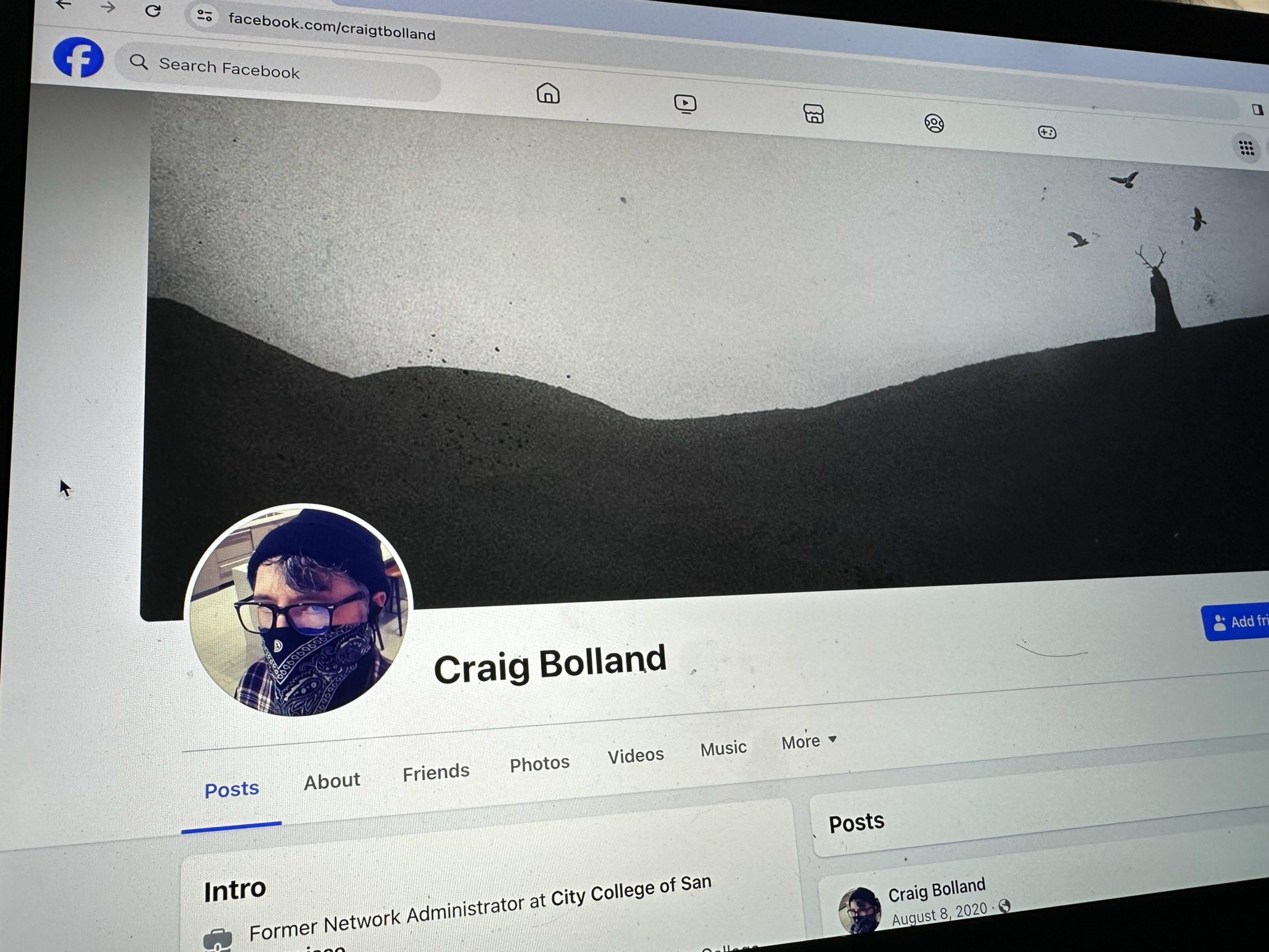For roughly two years, an Englishman and former IT technician secretly built an illegal armory in his North Beach apartment and supplied drug dealers and other criminals across the Bay Area with untraceable ghost guns he test-fired at San Francisco’s Fort Funston.
But it would take a catalytic converter theft case in the Richmond District and the arrest of a man in Visitacion Valley for San Francisco police to connect the dots that led to the arrest of ghost gun maker Craig Bolland, who was sentenced to six years in prison this month. It is unclear how many illegal weapons he made or sold.
Federal law enforcement called Bolland “a merchant of violence, arming those who spread destruction in this city and beyond.” Authorities came upon Bolland because he had “tried to sell firearms to someone who later shot at a police officer,” the U.S. Attorney said in a federal sentencing document.

Ghost guns—homemade firearms that are created by assembling pieces, sold in a kit or made by creating parts with 3D printers—are favored by criminals because they are unregistered, hard to track and have no identifying serial numbers.
READ MORE: San Francisco ‘Ghost Gun’ Dealer Pleads Guilty to Federal Weapons Charges
Sentencing documents in Bolland’s case detail the transformation of a long-sober IT technician into a San Francisco Bay Area arms dealer with a drug addiction who rose to become a broker of gun deals between others.
But longtime friends of Bolland’s counter the narrative created by federal law enforcement, saying the immigrant who grew up in Oregon was a talented musician and “shining light” who had drug issues but didn’t have a violent bone in his body.
Catalytic Converter Theft Turned Shooting
On Jan. 17, 2023, two San Francisco police officers responded to a report of thieves stealing catalytic converters from parked cars near Golden Gate Park. When cops arrived at Arguello Boulevard and McAllister Street, the suspects fled, and the officers chased them on foot before one of the alleged thieves opened fire on the officers.
No one was hurt, and one arrest was made, but the shooter got away.
Then on Jan. 23, the department’s gun crime unit arrested a man in Visitacion Valley for his alleged part in several shootings. When police arrived to arrest him, he tried to flee but was tackled. Then he pulled a gun, which went off but hurt no one. Police determined that that man, Spencer Hansen-Mukomela, 24, was the shooter at the catalytic converter incident.
The coup was lauded by Chief Bill Scott, who said police had taken a dangerous armed man off the street.
But the case would soon grow into a far more serious investigation that eventually led authorities to Bolland. Phone messages discovered by police showed that Hansen-Mukomela and Bolland had been negotiating a gun sale.
In their exchange, Bolland explained how quickly his ghost gun machine could make parts and how he used the beach at Fort Funston—a popular dog walking spot near Lake Merced—as a firing range to test out his wares. He said sending encrypted text messages on the Signal app was the safest way to talk about guns.

“I got no plans other than hitting the beach to test the latest batch,” wrote Bolland, adding later that he could share videos of the testing, too. “You welcome to come along later. We go to Fort Funston, super chill and the sounds are muffled by the ocean. Have a range set up out there.”
Bolland wrote that his ghost gun machine “takes 15 minutes to finish an m4 lower [the firearm’s handle area]. Love this thing.”
Bolland was arrested in front of his apartment in the 600 block of Green Street on May 30, according to San Francisco police, who also arrested Jose Reyes, 36, who was armed at the time.
The pair were on the street just three blocks from Washington Square Park at the center of North Beach.
When police and agents with the Bureau of Alcohol, Tobacco, Firearms and Explosives searched Bolland’s apartment, they found five complete weapons, including fully automatic AR-15 machine guns, as well as AK-47 parts, ammunition, two 3D printers and a ghost gun milling machine, which is used to drill and carve metal gun parts. Many weapons lacked serial numbers.
In a messaging exchange with an unidentified person that apparently occurred after his arrest, Bolland explained the depth of his operation and the potential time he faced.
“Dude, I have so much shit up there…I am going to go to prison for a long time…why didn’t I hide that shit…there is a switch Glock up there,” Bolland wrote, according to court documents.
Authorities say he had been manufacturing and selling guns for at least two years.

From ‘Black Sheep’ to IT Tech to Gun Maker
Bolland came to the United States with his mother from England when he was young, said Duncan Calver, who lived with Bolland in Portland 20 years ago. Bolland grew up outside of Portland with his mother, who had remarried, her new husband and several half-siblings.
Calver said that Bolland is a talented DJ and has a gift with language.
Stephen Arndt, a high school friend of Bolland’s, agreed, saying his friend was gifted at everything he did. “He was someone that all of us really respected and admired, the shining light of the group,” Arndt said.
But Bolland also had some issues with drugs and was at times at odds with his family, both friends said.
“He was a little bit of the black sheep of the family,” Calver said of his friend.
Arndt said Bolland moved to San Francisco in 2003.
While Calver and Arndt said they had not been in regular contact with Bolland for years, except via social media, the news of his conviction came as a shock.
“I never would have imagined he would get caught up in something like this,” Calver said.
Sometime after leaving Portland for San Francisco, Bolland became homeless and addicted to drugs, his attorney said in court filings. In 2006, when he was 22, he had a run-in with the law for commercial burglary, according to filings.
But by 2009, Bolland had gotten a job at the Goodwill on Fillmore Street, said Caleb Lawton, who also worked there. The two hit it off because of a mutual interest in DJing and electronic music, but Lawton said their friendship and partying led to both of them getting fired.
“I was in recovery. He was actively using. I ended up relapsing with him, which really fucked me up,” said Lawton, who didn’t speak with Bolland for some years afterward.
Despite his addiction and brush with crime, Bolland became sober a few years later via methadone treatment and therapy, according to his attorney. He then attended City College and became an IT technician.
But by 2021, that all came to an end.
Customers Wanted Missiles, Mines
Bolland began his illicit firearms business after losing his job as an IT technician and breaking up with his girlfriend during the pandemic, court documents say. Soon after losing his job, he relapsed and started using methamphetamine and fentanyl.
“This relapse, and its attendant effects on his employment and mental health, contributed directly to Mr. Bolland’s criminal conduct,” his lawyer wrote in court records.
In 2021, Bolland began ordering parts online and using his ghost gun machine to manufacture illegal firearms and alter existing weapons so they could be switched from semi to fully automatic mode, making them far more lethal. Court filings do not say how he learned to build guns or what drew him to it.
Bolland was paid by his clients, local drug dealers, among others, with drugs, money and even cryptocurrency, records say. Documents did not say how much he made in any of these deals.
Eventually, he branched out by brokering deals between buyers and sellers and even coordinating the logistics of handoffs, according to federal filings.
But his customers were also interested in more powerful weaponry. “He said he had customers interested in Stinger missiles, claymore mines, mortars, and grenade launchers,” filings say.
During this time period, Lawton said he saw Bolland after he, too, moved to North Beach. The two ran into each other a few times at the bus stop. While they only made small talk when they last saw each other about a year ago, Lawton was not as surprised by the conviction as Bolland’s other friends.
“I wouldn’t put it past him. He’s just really sharp. He’s a smart guy, smart enough to get himself into trouble,” he said, adding that drug use probably didn’t help with clear judgment.
Bolland pleaded guilty in September as part of a plea deal to four felony counts of firearm-related charges, including dealing and manufacturing firearms illegally. He was sentenced to six years in prison on Dec. 6.
His attorney did not respond to repeated calls for comment, but his friend, Lawton, said he was not a man of violence despite what the federal authorities said.
“He’s not like a bad guy, though,” Lawton said. “He’s not a violent guy.”
